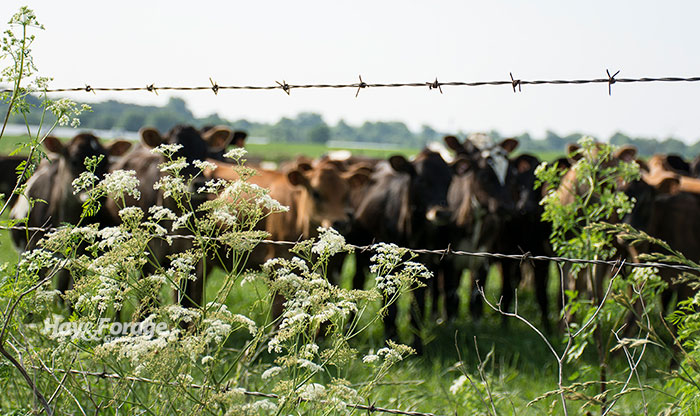
Don’t be fooled by the white flowers scattered across pastures and sprinkled along fence lines — they could be poison hemlock. This biennial weed grows quickly in the spring and can pack a toxic punch to humans and livestock.
Poison hemlock has a basal rosette growth pattern during its first year of development. The following year, it develops erect vegetative stems with lacy, fern-like leaves and white umbel flowers that are 7 to 15 inches in diameter.
Poison hemlock resembles other plants like wild carrot (also known as Queen Anne’s lace), wild parsnip, and water hemlock; however, its defining features are hairless stems with purple spots. Poison hemlock can also grow up to 6 feet tall, and all parts of the plant are poisonous, especially mature seeds.
Dwight Lingenfelter, an extension associate in weed science with Penn State Extension, says poison hemlock contains several pyridine alkaloids that are toxic to livestock at relatively small concentrations. Cattle can experience toxicosis if they eat 0.5% of their body weight in poison hemlock, which is 5 pounds of plant material per 1,000-pound animal. Poison hemlock is also toxic to humans if it is ingested.
Animals tend to avoid mature poison hemlock, but immature weeds can be rather palatable. Signs of toxicosis include dilated pupils, rampant or reduced heart rate, trembling, nervousness, coma, respiratory paralysis, and death. If animals display any of these signs, move them off pastures immediately and contact a veterinarian for proper treatment.
Control tactics
Poison hemlock can be controlled with mechanical or chemical practices. For the former, dig up individual plants with a shovel, making sure to remove taproots. The sap from poison hemlock can cause dermatitis in some people, so wear protective clothing and gloves when coming in contact with weeds.
Mow or use tillage to control more widespread infestations. In an article from Michigan State University Extension, Eric Anderson, Isabel Branstrom, and Erin Hill write that poison hemlock is capable of producing up to 38,000 seeds per plant. Eliminating plants sooner than later will help prevent future outbreaks.
“Seeds can germinate immediately or lay dormant for up to six years,” the authors state. “The plant will die soon after it sheds seed, but the stems will remain standing and slowly release seed into winter.”
Consider vegetation surrounding poison hemlock before applying herbicide to weeds. The authors suggest using products that contain 2,4-D, dicamba, clopyralid, and triclopyr — or a combination of these —when poison hemlock is growing among grasses. When weeds are growing on bare soil or in areas where surrounding vegetation is not of importance, broad-spectrum herbicides like glyphosate may be appropriate.
“If poison hemlock is growing among desirable broadleaf plants or shrubbery, mechanical removal is advised,” the authors note. “Remember to read and follow all labeled instructions prior to making any applications.”
Herbicides are most effective when they are sprayed during the first year of weed development or before flowering in the second year. Mature poison hemlock does not respond well to chemical control and will likely need to be removed mechanically.

Amber Friedrichsen served as the 2021 and 2022 Hay & Forage Grower summer editorial intern. She currently attends Iowa State University where she is majoring in agricultural communications and agronomy.

